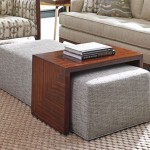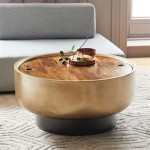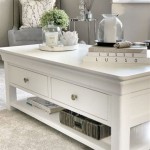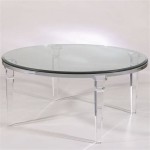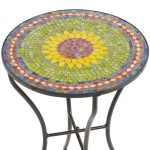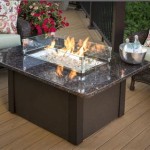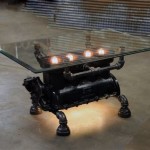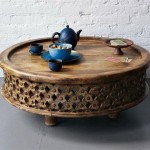How To Make A Large Square Coffee Table
Building a large square coffee table is a rewarding project that allows for customization of size, style, and finish to perfectly complement any living space. This guide provides a comprehensive approach to constructing a durable and aesthetically pleasing coffee table.
Gathering Materials and Tools
Careful preparation is essential for a smooth construction process. The following materials and tools should be assembled before beginning the project:
- Wood (e.g., Pine, Oak, Maple): Select kiln-dried lumber for optimal stability. The quantity will depend on the desired dimensions of the table.
- Wood Glue: High-quality wood glue is crucial for strong, lasting joints.
- Wood Screws: Choose screws appropriate for the thickness of the wood.
- Wood Filler: Used to fill gaps and create a smooth surface.
- Sandpaper: Various grits (e.g., 80, 120, 220) for smoothing and finishing.
- Wood Stain (Optional): Adds color and enhances the wood grain.
- Polyurethane or other sealant: Protects the wood and provides a durable finish.
- Measuring Tape: Accurate measurements are critical throughout the project.
- Pencil: For marking cuts and joinery locations.
- Circular Saw or Hand Saw: Used to cut the wood to the desired dimensions.
- Drill: For pre-drilling screw holes and driving screws.
- Screwdriver: For manually driving screws if necessary.
- Clamps: Essential for holding pieces together while the glue dries.
- Safety Glasses: Protect eyes from wood debris.
- Dust Mask: Prevents inhalation of sawdust.
- Table Legs (4): Select legs that complement the table's style and provide adequate support.
- Leg Attachment Plates: Used to securely attach the legs to the tabletop.
Building the Tabletop
The tabletop forms the main surface of the coffee table and requires careful construction for stability and visual appeal.
- Cut the Wood: Cut four pieces of wood to the desired length for the tabletop frame. These pieces will form the outer frame of the tabletop.
- Assemble the Frame: Join the four pieces using wood glue and screws, creating a square frame. Ensure the corners are square and the frame is flat.
- Cut the Support Boards: Cut several pieces of wood to fit inside the frame, creating support and a surface for attaching the tabletop surface. These are often referred to as "aprons" or "stretchers".
- Attach the Support Boards: Secure the support boards within the frame using glue and screws. These boards will provide additional structural integrity.
- Cut the Tabletop Surface: Cut a piece of plywood or solid wood to fit the top of the frame. This piece forms the visible surface of the tabletop.
- Attach the Tabletop Surface: Secure the tabletop surface to the frame using glue and screws, ensuring even contact and a flush finish.
Sanding and Finishing the Tabletop
Proper sanding and finishing are crucial for a smooth and aesthetically pleasing surface.
- Sand the Tabletop: Sand the entire tabletop surface, starting with a coarser grit (e.g., 80) and progressively moving to finer grits (e.g., 120, 220) to achieve a smooth finish. Pay attention to corners and edges.
- Fill Gaps and Imperfections (Optional): Apply wood filler to any gaps, cracks, or imperfections. Allow the filler to dry completely and then sand smooth.
- Apply Stain (Optional): If desired, apply wood stain according to the manufacturer's instructions. Multiple coats may be needed to achieve the desired color depth.
- Apply Sealant: Apply a protective sealant, such as polyurethane, to protect the wood and enhance its durability. Follow the manufacturer's instructions for application and drying times.
Attaching the Legs
Securely attaching the legs is the final step in completing the coffee table.
- Position the Legs: Position the legs at each corner of the tabletop, ensuring they are evenly spaced and aligned.
- Mark Leg Locations : Mark the location of the leg attachment plates on the underside of the tabletop.
- Attach Leg Attachment Plates: Screw the leg attachment plates to the underside of the tabletop at the marked locations.
- Attach the Legs to the Plates: Attach the legs to the leg attachment plates according to the manufacturer's instructions for the specific leg and plate type.
Final Inspection
A thorough final inspection ensures the stability and quality of the finished coffee table.
- Check Stability: Ensure the table stands firmly on the floor without wobbling. Adjust the legs if necessary.
- Inspect the Finish: Check the finish for any imperfections and address them as needed.
- Verify Functionality: Ensure the tabletop is level and provides a stable surface for intended use.

Large Square Coffee Table Makeover My Creative Days

Large Square Coffee Table Makeover My Creative Days

Diy Square Coffee Table Shanty 2 Chic

The Project Lady How To Build A Square Coffee Table With Turned Legs

Square Coffee Table W Planked Top Free Diy Plans Large Wood

The Project Lady How To Build A Square Coffee Table With Turned Legs

Large Square Coffee Table Makeover

Large Square Coffee Table Makeover My Creative Days

Brew Up A Creative Coffee Table Design Nell Hill S

34 Easy Ways To Update Your Lounge With A Large Square Coffee Table
Related Posts

